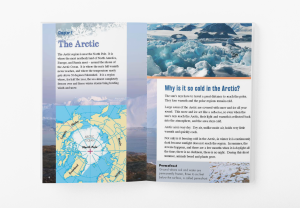
Graphical (or visual-) literacy is essential to support students to become critical consumers and producers of content-based texts.
In I See What You Mean: Visual Literacy, K-8 (2012), Steve Moline wrote, “We are all bilingual. Our second language, which we do not speak, but which we read and write every day, is visual.” Visual literacy, he goes on to say, is a complementary skill to the traditional literacy of words and sentences. It involves learning to read “visual texts.” Roberts, et. al. (2013) use the term “graphical literacy” to describe this understanding of how graphics function in informational texts. The ubiquitous occurrence of graphical elements, such as diagrams, graphs, and maps, in texts written for K-6 students means students must know how to decode and interpret these visual representations of meaning. And to be strong writers, they must understand how to purposefully use and craft visual texts.
So what matters for our young readers and writers as they encounter graphics?
Why Is It Important to be Able to Read Graphics?
All learning starts when students engage with a demonstration (Crouch and Cambourne, 2020). Learning to make meaning in graphical literacy is no different. Demonstrations that support students to understand how meanings are made from graphics are essential. Recognizing the purpose of different graphics, how these different graphics work, and how we read them are necessary understandings. However, along with demonstrations using graphics, how visuals and words integrate is also critical. Demonstrations of this integration in shared reading and opportunities to apply these understandings in guided reading and independent reading ensure students become strong meaning-makers who don’t over-rely on graphics but also don’t dismiss them either.
Experiencing Texts with Clear Models of Graphics
Children who read a lot of fiction expect ideas to be expressed through words; in fiction, illustrations, and other visuals fade out as text complexity increases. However, in many types of nonfiction, the opposite occurs the number and complexity of graphics increases as the complexity of the text increases. One of our roles as teachers is to ensure children have exposure and experience with text offering a full range of graphics. Teachers must select clear models that demonstrate the range of meanings communicated through graphics. Within each clear model, as graphics appear, discussions include not only the meanings being made from the graphic but consider the author’s decisions in including the graphic. These meaning-driven and metacognitive discussions support children to think like writers.
Composing Texts with Graphics
The discussions mentioned earlier of author decisions are a precursor to students composing their own pieces. As students compose their own pieces, they think about the ideas they want to communicate and then consider the type and placement of graphics to communicate those ideas just as the authors did in the mentor texts they’ve read and discussed. As they match the form of the graphic to their purpose and meaning, they experience and strengthen the reciprocal nature of reading and writing.
Graphic Literacy Examples
Well-written and content-rich nonfiction books with thoughtfully-crafted graphics, such as those found in Okapi’s WorldWise: Content-based Learning™ collection, capitalize on students’ curiosity and interest in the world. These books are written to engage young readers with intriguing content (who could resist a book titled Rock Snot, Cane Toads, and Other Aliens), help them consider their place in the world (Don’t Throw It Away is a thoughtful exploration of recycling), and reflect on the amazing world in which they live (The Salmon Stream details a journey which never fails to fascinate).
Visual literacy, as Moline concludes, is “the language that none of us speak but all of us use.” Developing students’ graphical literacy is vital.
Consider the range of graphics in the next nonfiction texts you use with students. How do the graphics support a reader’s meaning-making and contribute to their overall graphical literacy? Debra Crouch
